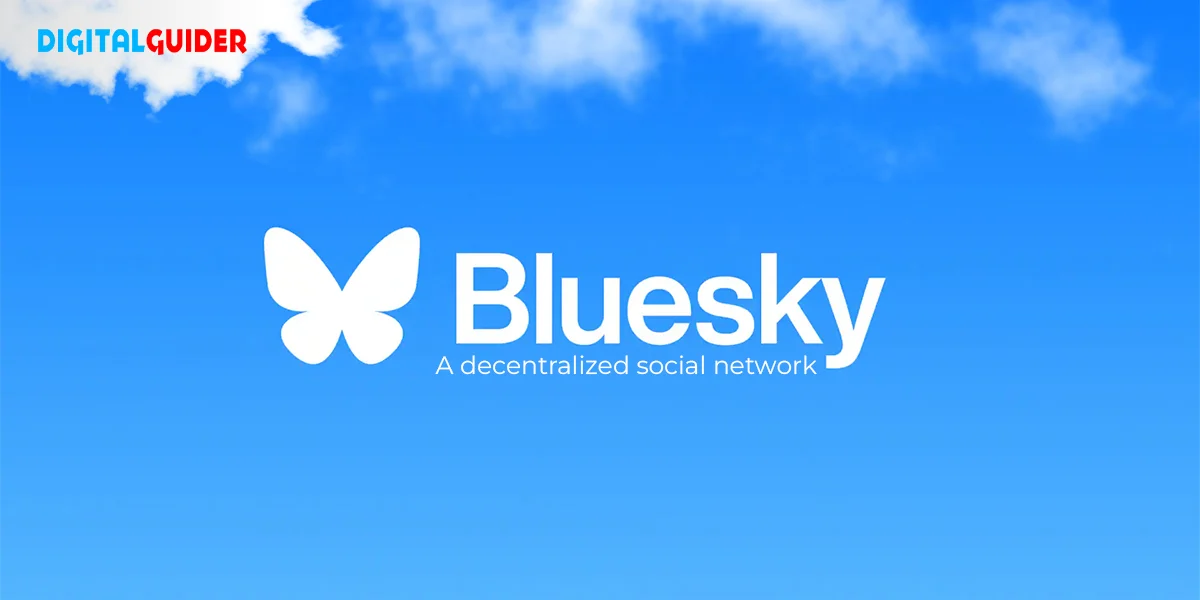It has been an incredible year for Bluesky Social. During the US presidential elections, it gained significant attention, attracting millions of new users.
Originating from a community of dedicated individuals, BlueSky is all about improving how we communicate and connect online.
Let’s explore Bluesky as a decentralized social networking site, the AT protocol, and how it can be an asset to the future.
What is BlueSky?
Bluesky is a microblogging social media service started by Jack Dorsey, the former CEO of Twitter, as an alternative to X (previously Twitter).
A research initiative that began in 2019 was made available to the general public on February 6, 2024. It’s a long journey from being part of Twitter to becoming an independent company made publicly available.
It hasn’t just made a place in social media and among the public. It reached approximately 25.9 million users (as of December 30), up only from 9 million in September 2024.
Like X, users can share short text messages and videos called “skeets.” Bluesky wants to create a social media network that is managed by several companies working together using a system called AT Protocol.
To understand Bluesky Social in a fun, interactive way, we can look at the cartoon on the Bluesky official blog site drawn by Davis Bickford. It speaks about their general availability and key features interestingly.

Source: Bluesky
AT Protocol & Features
AT Protocol is a decentralized framework that powers Bluesky. It is an open-source toolbox and interoperable social network that gives Bluesky users and developers more control over their data and interactions. This framework lets you move your account, choose algorithms, and customize moderation.
For instance:
Here’s a simple comparison to understand the AT protocol. The AT Protocol is like owning your phone number—you can change providers while remaining connected. It guarantees smooth communication and gives you control over your digital identity.
Working of AT protocol
Bluesky is working on the framework called AT Protocol. The core components of AT Protocol, DID (decentralized identifier) and PDS (personal data store), play a crucial role in enabling user control, privacy, and decentralized social networking.
The DID works as your unique, portable digital ID, which is not tied to a single platform. The portable ID (DID) can be used to log in, authenticate yourself, and take you further to the system supporting the AT Protocol. On the other hand, PDS stores all your data/information, such as posts, interactions and conversations. You are the owner of this data and can control who accesses it.
– Here are the steps on how DID (decentralized identifier) and PDS (personal data store) work systematically in the AT protocol and Bluesky.
Step 1: Creation of a decentralized identifier
When a user joins Bluesky, they are assigned a DID. It is a unique identity that serves as the user’s identity across platforms. It is not a centralized entity controlled by users with full ownership.
Step 2: Linking DID to PDS
The PDS is a decentralized storage system where the user’s data, like text, insertion, and messages, are stored. The PDS is secure data fully controlled by the user and linked with DID for easy access and management.
Step 3: Authentication and Interaction
When users log in or do things on Bluesky, their DID is used to confirm who they are. The DID checks the user’s identity and connects them to their PDS, which lets them safely access and change their data.
The DID also allows users to switch between different decentralized platforms using the same identity, so they don’t have to make a new account for each one.
Step 4: Privacy
The PDS allows users to share data selectively. A user is in complete control over the data with the use of DID and PDS. The shared content is visible to the public while others are kept private as per users’ choice.
Step 5: Trust and Verification
AT protocol keeps the trust intact among the users. The data storage and user verification are processed by DID & PSD. Therefore, a decentralized approach avoids relying on central authorities, providing greater security and control for the user.
Evolution of Bluesky Logo
Bluesky Social has changed since it was started in 2021, from its features to the Bluesky logo. The Bluesky logo has its variation from pattern to typography to its meaning. The Bluesky logo started evolving from 2021 (prerelease) to 2023 (when it got its official logo).
According to Logopedia (a wiki-hosting media), here is the evolution of the logo over the period:
The first logo was introduced with the name Bluesky social networking. The image represents an arrangement of distributed systems. It was introduced during the 2021-2023 (pre-release).

Source: Logopedia
The next logo was introduced and was used from February- December 2023. It had variations among itself. The image represents an open sky that shows freedom. It transformed into a plain blue background with a bird symbolic of freedom, expressing the idea of blue sky social media and its working. 
Source: Logopedia
The blue background with birds also represented Twitter (X), freed from the cage of a centralized network. Bluesky is decentralized and gives users more control over data and the system. It was marked by Bluesky’s official website by a post saying, ‘Out of the platform, to the protocol symbolizing the ‘open space of possibilities.’

Source: Bluesky
Before the public launch in December 2023, the new logo (also the present) was introduced with a butterfly and typography. The butterfly shows Bluesky’s promise to build a decentralized social media platform that focuses on users, highlighting openness and freedom.
This new logo represents Bluesky’s goal to improve and change social media.

The users accepted this logo, and it has been the face of Bluesky social from 2023 to the present.
Features of Bluesky Social

Decentralized Network
Bluesky uses the AT Protocol, which lets users and communities control their data and social media experience. This setup gives users more freedom.
Customizable Algorithms
Users can change their feeds by choosing or making their own algorithms, allowing them to decide what content they want to see.
Portability
The platform allows users to easily move their profiles, followers, and data to different platforms within the AT Protocol system.
Interoperability
Bluesky works well with other apps and services that use the AT Protocol, encouraging teamwork and communication across different platforms.
Focused on Privacy and Security
Bluesky cares about user privacy, giving people control over their data and reducing the chances of censorship or spying.
Simplified User Interface
It has a simple and easy-to-use design, making it straightforward for new users to find their way and interact with content.
Community-Centered Development
It includes its users in making decisions about the platform’s features and rules, ensuring it meets their needs.
Open-Source Foundation
The platform is open about how it is built, inviting developers worldwide to contribute and create new ideas.
Why Corporates Embrace Bluesky Engagement?
Engagement is an important factor in social media because it increases visibility, builds community connections, and extends content reach. The change from Twitter to X under Musk changed the social media scene, leading users to move to different platforms and altering how people interact online.
The downfall of Twitter (X) gained users in platforms like Meta, Threads, and Bluesky social. Though the later one is much smaller (23M users) as compared to Threads (275M) & X (535M), it shows higher engagement.

Source: Bluesky
Bluesky social became popular in a short period among other versatile social media sites. It is a likable option for independent developers, giving them more freedom and control. The open protocol allows developers, publishers and businesses to build custom tools and apps on top of the platform. It provides flexibility to tailor social media strategy.
As per Bluesky’s official blog site, here are some testimonies from independent developers like The Boston Globe, The New York Times, The Guardian, open source, web dev, etc.

Source: Bluesky
How to create a Bluesky account?
To create a Bluesky account, you can use your browser or a mobile app. The application is available for download from the Google app store (for Android users) and Apple store (iOS users).
The reference picture for creating an account is from the web, but it also acts similarly for the app version.
Here are the steps to set up a Bluesky account:
- Go to the Bluesky social media website on your browser.
- Click on Log In or Sign Up.

- From the next page, select Sign up

- Next, you will be asked for your information to create the account.
– Enter your email address.
– Enter your date of birth.
– Create a password for your Bluesky account.
– Click Next.

- Next, you have to create your username. The username should only consist of letters, numbers, & hyphens.
- Click Next
- The next step is to do a CAPTCHA challenge

- Upload your profile picture or create an avatar.
![]()
- To customize your feed, select your interest from the available options.

- Click Continue.
- Click on Let’s Go! And enjoy the Bluesky social.
Bluesky Social is set to transform social life in 2025 by giving users a more controlled and decentralized networking platform. It is an alternative to traditional platforms like Twitter, Instagram, Facebook, and Threads. Bluesky’s open-source system lets users manage their data and interactions, making the online space honest and transparent for all generations. From millennials to GenZ, all engage with communities in a more authentic and secure environment, potentially changing how users tend to communicate, connect, and share online in years ahead.
FAQs–
- Is Bluesky free?
Yes, Bluesky is free for the public to use.
- Is there an age restriction for joining Bluesky’s social media?
Yes, users must be at least 13 years old to join Bluesky.
- Are there specific terms for US government officials using Bluesky social?
US government officials must comply with the terms of the Service Amendment for Government Users.
- How can I delete my Bluesky account?
Go to account settings Select “Delete account” & follow the prompts. The action is permanent.
- Can I report toxic behavior on the Bluesky account?
Yes, users can report harmful behavior directly through features like- in-app reporting features, automated moderation tools & content filters.
- How can a brand build trust in Bluesky?
Brands can build trust by promoting authentic, transparent connections without ads or algorithms.
- Can businesses customize their presence on Bluesky?
Yes, businesses can tailor profiles, content, & tools (Swat.io, Vista Social, etc.) to fit their brand.
- Which tools can enhance the business presence on Bluesky?
The tools like Swat.io, Vista Social, SocialBee, Fedica, & SocialChamp help with content scheduling, management & engagement.
- Can businesses run targeted ads on Bluesky?
No, Bluesky doesn’t support targeted ads.
- Can AI tools work with Bluesky profiles?
The AI integration is not possible now, but might be possible as the Bluesky features evolve.
- Why can’t I use my Twitter account on my Bluesky account?
Bluesky uses a different protocol (AT protocol), so direct transfer of Twitter accounts is not possible.







